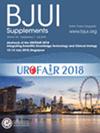Tumour size is associated with growth rates of >0.5 cm/year and delayed intervention in small renal masses in patients on active surveillance
Abstract
Objective
To evaluate the association between tumour size and the growth rate (GR) of small renal masses (SRMs) in patients managed by active surveillance (AS).
Materials and Methods
We queried the prospective, multi-institutional Delayed Intervention and Surveillance for Small Renal Masses (DISSRM) registry for patients on AS with an imaging interval of ≥6 months, identifying 456 patients. We tracked tumour size over time; a GR >0.5 cm/year was defined as a GR event. We used multivariable recurrent events and time-to-event Cox regression modelling to evaluate the association between tumour size and GR events (primary outcome) and tumour size and delayed intervention (DI; secondary outcome). We tested tumour size as a continuous variable and dichotomised tumour size by predefined (2-cm) and calculated (2.9-cm) cutoffs. We calculated the cutoff using maximally selected rank statistics and time to progression, defined according to the DISSRM registry.
Results
The median (interquartile range) follow-up of patients on AS was 40.1 (26.4–71.2) months, during which 128 patients (28%) had ≥1 GR event, and 80 (18%) underwent DI. Larger tumour size was an independent predictor for GR events and DI when tested as a continuous and a dichotomous variable in multivariable analyses (all P < 0.05). The association was strongest when accounting for the change in tumour size over time and when applying the 2.9-cm cutoff. The study is limited by the mixed tumour pathology inert to SRMs.
Conclusion
Larger tumour size was independently associated with GR events and DI for patients with SRMs on AS. A 2.9-cm cutoff may provide valuable information for patient counselling.

 求助内容:
求助内容: 应助结果提醒方式:
应助结果提醒方式:


